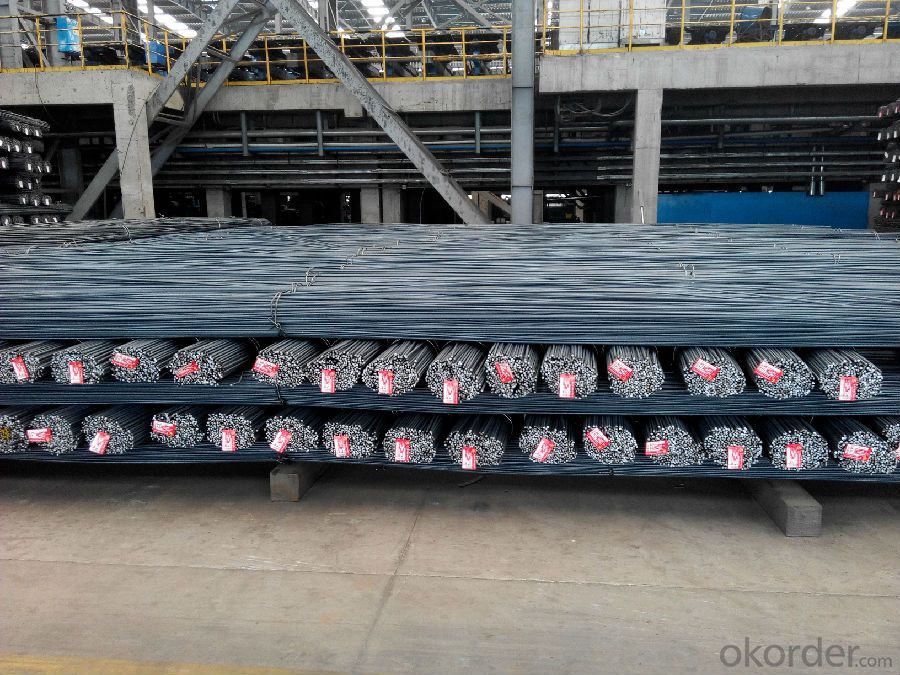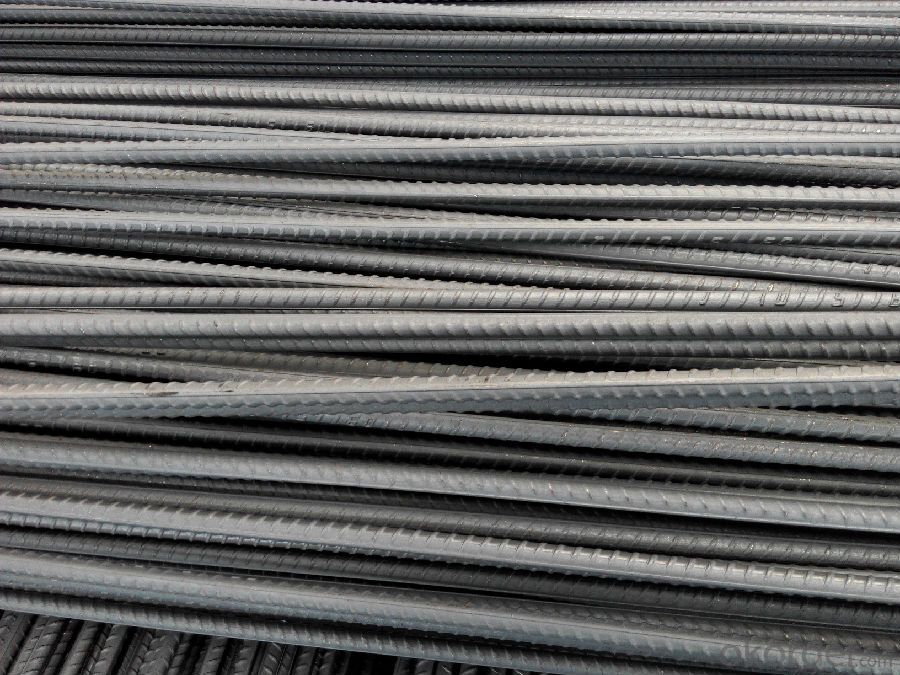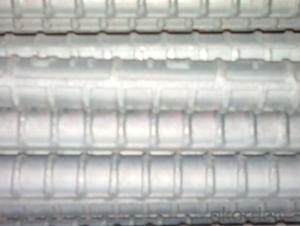ASTM Standard Deformed Steel Rebar GR40, GR60
- Loading Port:
- Tianjin
- Payment Terms:
- TT OR LC
- Min Order Qty:
- 25 m.t.
- Supply Capability:
- 200000 m.t./month
OKorder Service Pledge
OKorder Financial Service
You Might Also Like
Item specifice
Product Description:
OKorder is offering ASTM Standard Deformed Steel Rebar GR40, GR60 at great prices with worldwide shipping. Our supplier is a world-class manufacturer of steel, with our products utilized the world over. OKorder annually supplies products to European, North American and Asian markets. We provide quotations within 24 hours of receiving an inquiry and guarantee competitive prices.
Product Applications:
ASTM Standard Deformed Steel Rebar GR40, GR60 is widely used in buildings, bridges, roads and other engineering construction. Big to highways, railways, bridges, culverts, tunnels, public facilities such as flood control, dam, small to housing construction, beam, column, wall and the foundation of the plate, deformed bar is an integral structure material. With the development of world economy and the vigorous development of infrastructure construction, real estate, the demand for deformed bar will be larger and larger.
Product Advantages:
OKorder's ASTM Standard Deformed Steel Rebar GR40, GR60 are durable, strong, and resist corrosion.
Main Product Features:
· Premium quality
· Prompt delivery & seaworthy packing (30 days after receiving deposit)
· Corrosion resistance
· Can be recycled and reused
· Mill test certification
· Professional Service
· Competitive pricing
Specifications of Hot Rolled Deformed Steel Rebars for ASTM Standard Deformed Steel Rebar GR40, GR60
Standard | GB UK USA | HRB335 HRB400 HRB500 G460B, B500A, B500B,B500C GR40, GR60 | |
Diameter | 6mm,8mm,10mm,12mm,14mm,16mm,18mm,20mm, 22mm,25mm,28mm,32mm,36mm,40mm,50mm | ||
Length | 6M, 9M,12M or as required | ||
Payment term | TT or L/C | ||
Trade terms | FOB, CFR, CIF | ||
Application | Building, construction | ||
Each bundle weight | 2-3MT, or as required | ||
Type | Hot rolled steel rebar | ||
Brand name | OKORDER | ||
Theoretical weight and section area of each diameter as below for your information:
Diameter(mm) | Section area (mm²) | Mass(kg/m) | Weight of 12m (kg) | Pcs/ton |
6 | 28.27 | 0.222 | 2.664 | 375.38 |
8 | 50.27 | 0.395 | 4.74 | 210.97 |
10 | 78.54 | 0.617 | 7.404 | 135.06 |
12 | 113.1 | 0.888 | 10.656 | 93.84 |
14 | 153.9 | 1.21 | 14.52 | 68.87 |
16 | 201.1 | 1.58 | 18.96 | 52.74 |
18 | 254.5 | 2.00 | 24 | 41.67 |
20 | 314.2 | 2.47 | 29.64 | 33.74 |
22 | 380.1 | 2.98 | 35.76 | 27.96 |
25 | 490.9 | 3.85 | 46.2 | 21.65 |
28 | 615.8 | 4.83 | 57.96 | 17.25 |
32 | 804.2 | 6.31 | 75.72 | 13.21 |
36 | 1018 | 7.99 | 98.88 | 10.43 |
40 | 1257 | 9.87 | 118.44 | 8.44 |
50 | 1964 | 15.42 | 185.04 | 5.40 |


- Q:What are the guidelines for proper cover thickness of steel rebars in concrete structures?
- The guidelines for proper cover thickness of steel rebars in concrete structures are crucial to ensure the durability and structural integrity of the construction. Here are the general guidelines for the cover thickness: 1. Building codes and regulations: Always refer to the local building codes and regulations, as they provide specific requirements for the cover thickness of steel rebars in concrete structures. These codes are developed based on extensive research, testing, and engineering standards to ensure the safety and longevity of the structure. 2. Environmental conditions: Consider the environmental conditions where the structure will be located. Factors such as exposure to corrosive substances, humidity, temperature changes, and seismic activity can affect the required cover thickness. In harsher environments, thicker covers may be necessary to provide adequate protection against corrosion. 3. Rebar diameter: The diameter of the steel rebars also plays a role in determining the appropriate cover thickness. Smaller diameter rebars may require a thinner cover compared to larger diameter rebars to maintain proper strength and prevent corrosion. 4. Structural design considerations: The design of the concrete structure, including load-bearing capacity, reinforcement layout, and anticipated stresses, should be taken into account when determining the cover thickness. Consulting with a structural engineer is essential to ensure the correct cover thickness is determined based on the specific design requirements. 5. Concrete quality: The quality and type of concrete used in the construction also affect the required cover thickness. Higher-grade concrete with better resistance to corrosion may allow for a thinner cover, while lower-grade concrete might require a thicker cover to provide adequate protection to the rebars. 6. Construction process: The construction process itself can impact the cover thickness. Proper placement and compaction of the concrete, as well as careful handling of rebars during installation, are vital to maintain the desired cover thickness. Construction workers and contractors should be trained and knowledgeable about the correct procedures to ensure the appropriate cover thickness is achieved. Following these guidelines is essential to ensure the long-term durability, safety, and performance of concrete structures. It is always recommended to consult with a qualified structural engineer or other relevant professionals to determine the specific cover thickness requirements for a particular project.
- Q:What are the guidelines for proper splicing of steel rebars in concrete structures?
- The guidelines for proper splicing of steel rebars in concrete structures include ensuring proper alignment and overlap between rebars, using appropriate splicing methods such as lap splices or mechanical couplers, and ensuring adequate concrete cover over the spliced area. Additionally, it is essential to follow the specific codes and regulations set by relevant authorities and consult structural engineers for accurate and safe splicing practices.
- Q:Are steel rebars susceptible to stress corrosion cracking?
- Yes, steel rebars are susceptible to stress corrosion cracking, particularly in environments with high chloride content such as coastal regions or areas with deicing salts. The combination of tensile stress, corrosion, and the presence of certain corrosive agents can lead to the formation and propagation of cracks, compromising the structural integrity of the rebars.
- Q:Are steel rebars magnetic?
- Yes, steel rebars are magnetic as they are typically made from carbon steel, which is a ferromagnetic material.
- Q:How do steel rebars contribute to the strength of a structure?
- Steel rebars contribute to the strength of a structure by providing reinforcement and enhancing its structural integrity. These high-strength steel bars are embedded within concrete to resist tensile forces that concrete alone cannot withstand. By distributing stress and preventing cracking or failure, rebars help ensure the overall stability and durability of the structure, especially in areas prone to seismic activity or heavy loads.
- Q:How are steel rebars used in the construction of oil and gas refineries?
- The strength and durability of steel rebars make them widely used in the construction of oil and gas refineries. These rebars, made from high-strength steel, reinforce concrete structures and increase their load-bearing capacity. In the construction of oil and gas refineries, steel rebars are primarily utilized in various reinforced concrete structures like foundations, columns, beams, slabs, and walls. These structures are crucial for supporting heavy equipment, storage tanks, processing units, and other essential refinery components. During construction, rebars are embedded in the concrete, forming a reinforced framework that can withstand high loads, seismic activity, and extreme weather conditions. The steel reinforcement enhances the concrete's tensile strength, making it more resistant to cracks and structural failure. Furthermore, the use of rebars ensures the long-lasting nature of refinery infrastructure. Oil and gas refineries operate in harsh environments with exposure to chemicals, high temperatures, and corrosive agents. Steel rebars possess excellent corrosion resistance, which is vital for maintaining the structural integrity of the refinery. Moreover, rebars facilitate the construction of complex shapes and configurations required in refinery structures. They can be bent, cut, and molded to fit specific design requirements, enabling the creation of intricate concrete structures essential for the refinery's functionality. Overall, steel rebars play a vital role in oil and gas refinery construction, providing necessary reinforcement to concrete structures. Their strength, durability, and corrosion resistance make them ideal for enduring the demanding conditions in these facilities, ensuring the safety and longevity of the refinery infrastructure.
- Q:What is the process of pre-stressing steel rebars?
- The process of pre-stressing steel rebars involves applying a predetermined amount of stress or force to the rebars before they are subjected to loading. This technique is commonly used in the construction industry to improve the structural strength and durability of concrete structures. The process typically starts with the selection of high-strength steel rebars that have good tensile strength properties. These rebars are usually made from carbon steel or alloy steel and come in various sizes and shapes, depending on the specific application. Once the rebars are selected, they are cleaned and coated with a protective layer to prevent corrosion. After that, the rebars are placed into the desired position within the concrete structure, such as beams, columns, or slabs, according to the design specifications. Next, the pre-stressing process begins. There are two primary methods for pre-stressing steel rebars: pre-tensioning and post-tensioning. In pre-tensioning, the rebars are initially tensioned by fixing them to an anchorage point or a strong frame. The opposite end of the rebars is then pulled using hydraulic jacks or mechanical devices, applying a significant amount of force. Once the desired stress is achieved, the rebars are secured in their stressed position by casting concrete around them. After the concrete has hardened, the jacks or devices are released, transferring the stress to the rebars. In post-tensioning, the rebars are first placed into the concrete structure without any initial tension. After the concrete has hardened, a series of ducts or channels are created within the structure, running along the path of the rebars. High-strength steel strands or cables are then inserted through these ducts. The strands are anchored at one end of the structure and tensioned using hydraulic jacks or similar devices. This tensioning process applies a force to the rebars, which is transferred to the concrete, compressing it. Once the desired stress is achieved, the strands are secured and the ducts are filled with grout or mortar to protect them from corrosion. Both pre-tensioning and post-tensioning techniques result in pre-stressed steel rebars that provide several benefits to concrete structures. These include increased load-carrying capacity, improved resistance to cracking and deformation, enhanced durability, and overall better structural performance. The process of pre-stressing steel rebars is a vital aspect of modern construction practices, ensuring the longevity and safety of various types of concrete structures.
- Q:Can steel rebars be used in pre-stressed concrete construction?
- Yes, steel rebars can be used in pre-stressed concrete construction. In pre-stressed concrete, steel rebars are commonly used to provide additional strength and reinforcement to the concrete structure. These rebars are placed strategically and pre-tensioned or post-tensioned to withstand the applied loads and enhance the overall performance and durability of the construction.
- Q:Are steel rebars suitable for use in historical restoration projects?
- Yes, steel rebars can be suitable for use in historical restoration projects. They provide structural reinforcement and can help strengthen deteriorated or weakened elements of historical buildings. However, careful consideration should be given to ensure that the use of steel rebars aligns with the original materials and techniques used in the construction of the historical structure. Additionally, the visual impact and authenticity of the restored elements should be taken into account, as steel rebars may not always be ideal for maintaining the historical integrity of the building.
- Q:What are the guidelines for storing steel rebars on a construction site?
- The guidelines for storing steel rebars on a construction site typically include keeping them off the ground to prevent rust and corrosion, stacking them neatly and securely to avoid accidents, and protecting them from exposure to moisture and other harmful elements. It is also important to separate different sizes and types of rebars to ensure easy identification and accessibility when needed.
1. Manufacturer Overview |
|
|---|---|
| Location | |
| Year Established | |
| Annual Output Value | |
| Main Markets | |
| Company Certifications | |
2. Manufacturer Certificates |
|
|---|---|
| a) Certification Name | |
| Range | |
| Reference | |
| Validity Period | |
3. Manufacturer Capability |
|
|---|---|
| a)Trade Capacity | |
| Nearest Port | |
| Export Percentage | |
| No.of Employees in Trade Department | |
| Language Spoken: | |
| b)Factory Information | |
| Factory Size: | |
| No. of Production Lines | |
| Contract Manufacturing | |
| Product Price Range | |
Send your message to us
ASTM Standard Deformed Steel Rebar GR40, GR60
- Loading Port:
- Tianjin
- Payment Terms:
- TT OR LC
- Min Order Qty:
- 25 m.t.
- Supply Capability:
- 200000 m.t./month
OKorder Service Pledge
OKorder Financial Service
Similar products
New products
Hot products
Related keywords





























